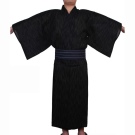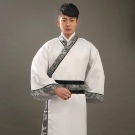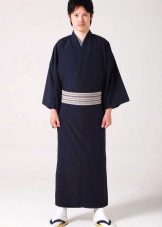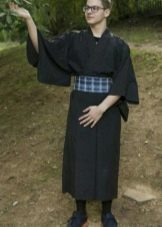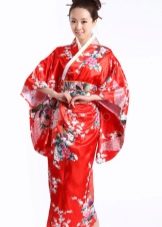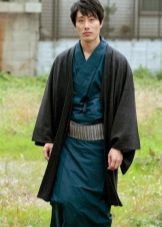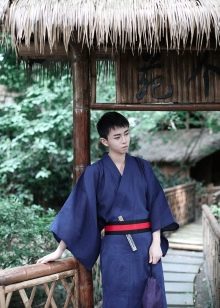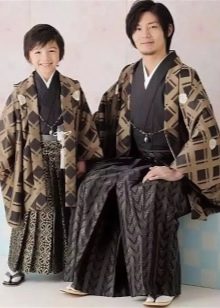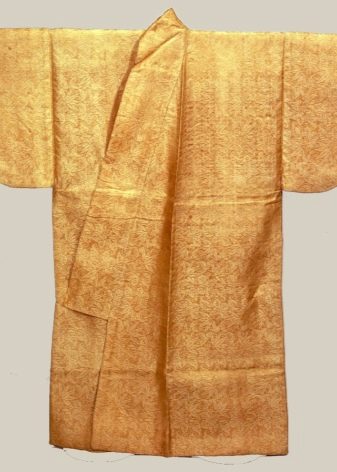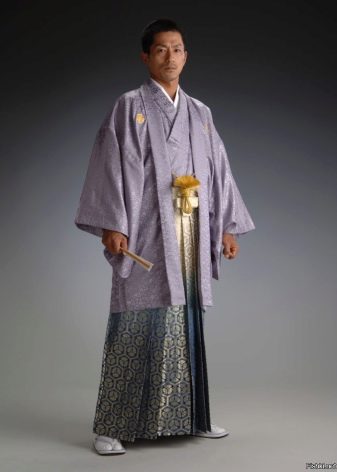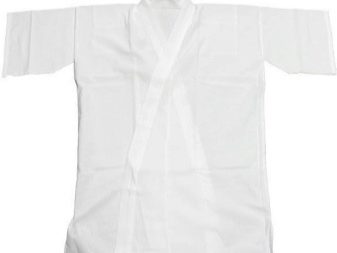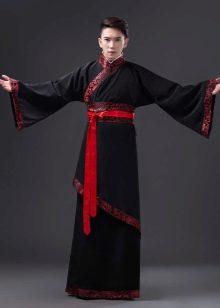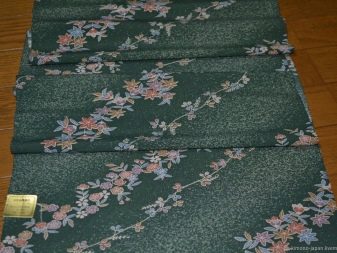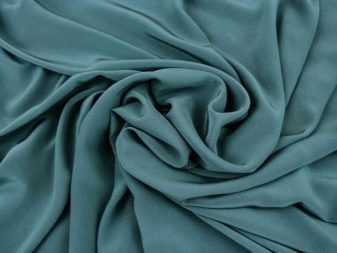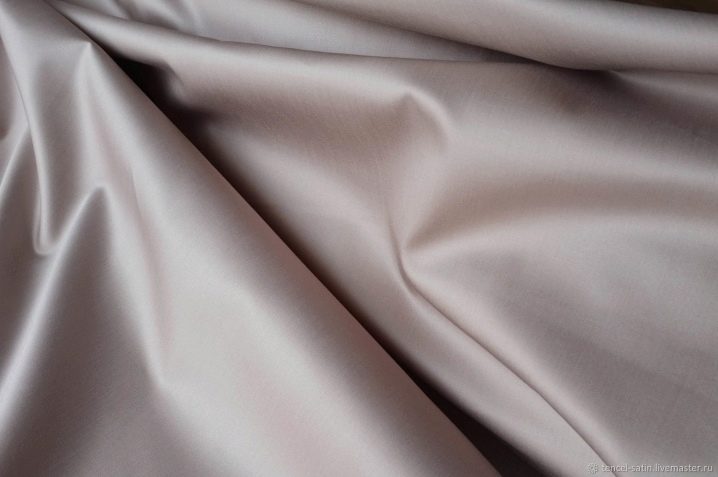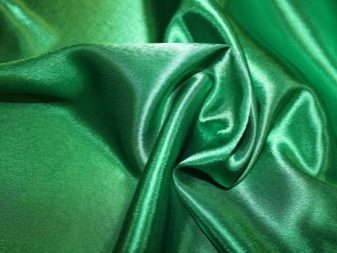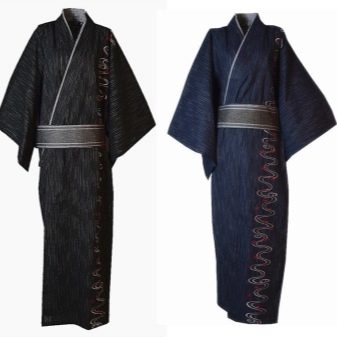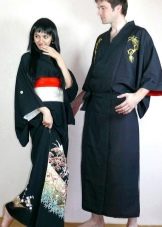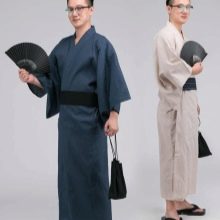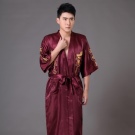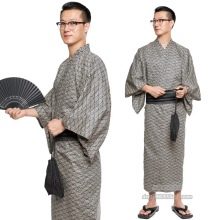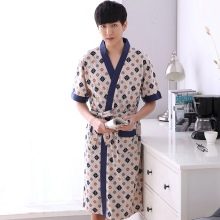Men's kimono: an overview of the types and secrets of choice
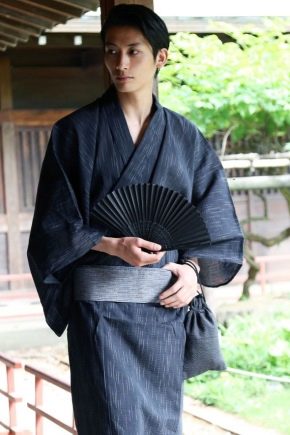
The men's kimono was once a traditional type of clothing for the inhabitants of the countries of the East. Choosing a Japanese yukata for home or ceremonial occasions is an important part of an adult's life today. This wardrobe item is always worn, combined with other elements of the outfit, taking into account the established rules. How to choose and distinguish a Chinese casual silk kimono and other types of clothing from Japan, how the male version differs from the female one - all these questions should be considered more carefully.
Peculiarities
A men's kimono must fully comply with certain requirements and traditions. It necessarily has a T-shaped silhouette, created from 1 cut of fabric. There are no clasps, instead of them, the plowing of the floor of the clothes and tying with an obi belt is used. In a men's wardrobe, it is quite narrow, only the shoulder line and waist are accentuated, all other features of the physique remain hidden. The sleeves are baggy, not too tight around the arm.
For a man's kimono, its upper sleeve part must fall down to the elbow without the formation of folds... It is shorter than the female one and provides greater freedom of movement. You can put on such an outfit on your own, without resorting to outside help. The belt is tied from the waist to the hips, fixed with a knot at the back or on the right.
Men wear a kimono combined with a hakama - These are wide trousers that have folds and look like a skirt. Today they are used mainly in martial arts, previously worn by samurai. The length of the hakama extends from the waist to the ankles, and there are also shortened versions. In ancient times, only courtiers, soldiers and clergymen had the right to wear this piece of clothing. The hakama is worn over a kimono and in traditional dress is complemented by a lumbar pad to improve posture.
Men's kimonos are only common in Japan. In other Asian countries, although national clothes have similar features, they are called differently.
Comparison with female
In comparison with the female version, the male kimono is always simpler. The outfit is composed of no more than 5 items, including shoes. The sleeves of traditional clothing for men are long, connected to the "body" of the wardrobe item. They are narrower, not as deep. When tying the obi belt, it is at the waist, just below the edge of the sleeve.
There are also differences in the selection of fabric. For men, matte natural fabrics without excess shine are most often used. Formal outfits are more textured, while everyday outfits are usually sleek. They are characterized by the presence of coats of arms kamon on the chest - these insignia can be from 3 to 5. Men's kimonos come in different sizes, while women's kimonos have only one.
The color scheme of men's kimonos is also noticeably more modest than that of women. For example, black, dark blue, green tones, as well as all shades of brown, from ocher to dark chocolate, are chosen for daily wear. Let's say a discreet drawing. Ceremonial kimonos for men are made of blue, purple, grassy green fabric, it is more shiny. Sumo wrestlers wear this wardrobe item as formal wear, preferring very bright shades - fuchsia, burgundy.
Both male and female kimono always worn with a wrap from left to right. The opposite option applies only to the deceased at burial. A change in smell indicates that a person has passed to the opposite world.
Types and materials
Homemade kimono - yukata, a traditional type of clothing in Japan... It is distinguished by soft colors, it is considered everyday.In Japanese tradition, tourists are also encouraged to wear the yukata kimono. It is he who can be found in hotels instead of dressing gowns, in this case the clothes will be decorated with the hotel's corporate logo. Street yukata are considered summer, they are denser, brighter, complemented by beautiful belts.
Hanten - this is the name of a cape, cut by analogy with a kimono. This type of traditional dress is worn during the colder seasons. Hanten can also be female and male, and there is always a cotton lining in it. It is also used as outerwear if you need to go out. The color scheme and ornament of such items are quite diverse.
All kimonos that do not belong to the home wardrobe are usually divided into upper and lower. Models with short sleeves are called kosode, with long sleeves - furisode. Traditional kimono (not yukata) has a more accurate designation - wafuku. Usually it is silk, while home options are sewn from simpler fabrics - cotton, polyester, mixed fabrics.
Hadajuban is a lower kimono worn over a special undershirt. It is shorter, usually plain, can be decorated and painted, with longer sleeves and decorative cuffs. The collars of the lower naga-juban kimonos are interchangeable, they are chosen depending on the colors of the upper wafuku. Hada-juban is more like a nightgown.
The Chinese prototype of the kimono is called hanfu. Today it is not used in everyday life, but sometimes it is worn for special events, rituals, ceremonies, and is also used in the reconstruction of historical events. Taoist monks wear the Daopao, a subtype of Hanfu. The hem of the clothes is wrapped to the right, the collar is also cross. Allocate a wearable version - "and", a robe "pao", outerwear of this type is called "shan".
Popular materials for making kimonos.
- Silk. An exceptionally natural look of this material, obtained from silkworm cocoons, is appropriate in a kimono. It has a characteristic odor and antibacterial properties. The very dense tsumugi silk is highly prized. Thin options are used when sewing a lower kimono.
- Crepe silk. It is made of natural silk, has a grainy, rough texture of the canvas. In production, threads twisted in different directions are used. The fabric can be pure crepe, with a pronounced pattern, semi-crepe.
- Satin. A fabric with a special weave of fibers of Chinese origin. Made from natural silk or cotton threads. Satin has a pronounced division into the front and the wrong side, it is durable, strong, heavy enough, drapes well and keeps its shape.
- Crepe satin. It is a natural or synthetic silk material. During the production, a satin weave of threads is used, due to which the front is formed - smooth and shiny, as well as a matte back side.
Highly prized for its excellent drape, crepe satin is heavy and dense enough to create traditional kimono tops.
- Cotton. It is represented by a wide variety of fabrics, obtained from plant materials, the fibers are short, soft and thin, slightly fluffy. Cotton fabrics are easily wrinkled, but they are hygroscopic, easy to dye, and easy to clean. When sewing a kimono, the shrinkage of the fibers is taken into account.
- Hemp canvas. It is traditionally used in yukata sewing. Such a fabric is stronger than cotton, more resistant to stretching and deformation, and wear-resistant. The raw materials are of vegetable origin.
The technology of its processing is rather complicated, the fabric goes through the stage of bleaching or dyeing, the weaving of threads is usual.
- Linen. Easily crushed dense plant material. It is characterized by the presence of an exquisite matte shine, durability, ease of care, high hygroscopicity. The fabric is completely environmentally friendly, it lends itself well to dyeing.
- Polyester. Polyester fabric made from fully synthetic raw materials. For the production of fabrics, it is used in combination with fibers of wool, cotton, viscose. Externally, polyester resembles cotton fabrics, but has increased strength and density.
These are just a few of the materials traditionally used in kimono making. In fact, they can be created from almost any fabric that has the ability to drape well and hold its shape.
Design options
The pattern of the traditional Japanese kimono is determined by the season of its use. There are 28 color options in total, and they begin to wear the corresponding option about 2 weeks before the onset of the desired time period.... Men's plain wafuku are worn upon reaching the age of 30; before this age, it is customary to choose colored models or with original ornaments. Usually kimonos and hakama are made in contrasting colors.
If the fabric is thin, men's kimonos are sewn with a lining. Winter insulated options have wadded lining, they are quilted, they look very respectable.
Ordinary cotton and linen yukata are rarely hand-painted. In the color version, they are covered with a medium-sized printed design with geometric patterns. The design of silk wafuku models depends on many factors, but in general it is not customary to decorate and decorate them richly. Most often used here ornaments of the Taisho-Showa era, floral and animalistic motives. Ritual and funeral kimonos are always white.
How to choose?
The choice of a men's kimono is primarily determined by the purpose for which this wardrobe item is purchased. Among the most common reasons, several can be noted.
- Replacing a dressing gown... Europeans often want to experience the exotic. For home, it is enough to buy the traditional version of the yukata made of cotton or linen.
- Desire to join Japanese fashion... In this case, it is better to pay attention to rather formal outfit options. They are also suitable for participation in official ceremonies, events related to the culture of Japan.
- Decorative functions. When decorating an Asian-style interior, this element is considered almost a must-have addition.
- Participation in a costume performance, holiday, photo session... Here you can not be especially zealous in the accuracy of details, but the savings on quality will be quite noticeable.
- Integration into the European everyday wardrobe... Modern fashionistas sometimes find very non-trivial ways to use a man's kimono in their outfit.
- Sports activities. It all depends on the type of martial arts. In most cases, this name refers to the dogi used in karate. It is better to clarify which cut option will be optimal.
It is worth knowing that the factor of seasonality in most cases, when it is not about participation in official events, it is not necessary to take into account... That is, you can wear almost any ornament on the fabric. When it comes to ceremonial dress, you have to determine which of the 28 seasons corresponds to the date of the event.
Buying a men's kimono as an original interior detail provides for the selection of the most expensive and conspicuous models. Bright, antique, deliberately luxurious wardrobe items will set the tone for the entire design decision. In this case, exactly it is not worth saving, then the result will be appropriate.
Yukata made of cotton or linen are most often purchased as home clothes. They are street and those that are worn behind the closed doors of their own home - not to be confused. In addition, at home you can wear naga-juban - a lower kimono. It is made from fine silk and looks much more exotic. Putting it on the street is considered bad form.








